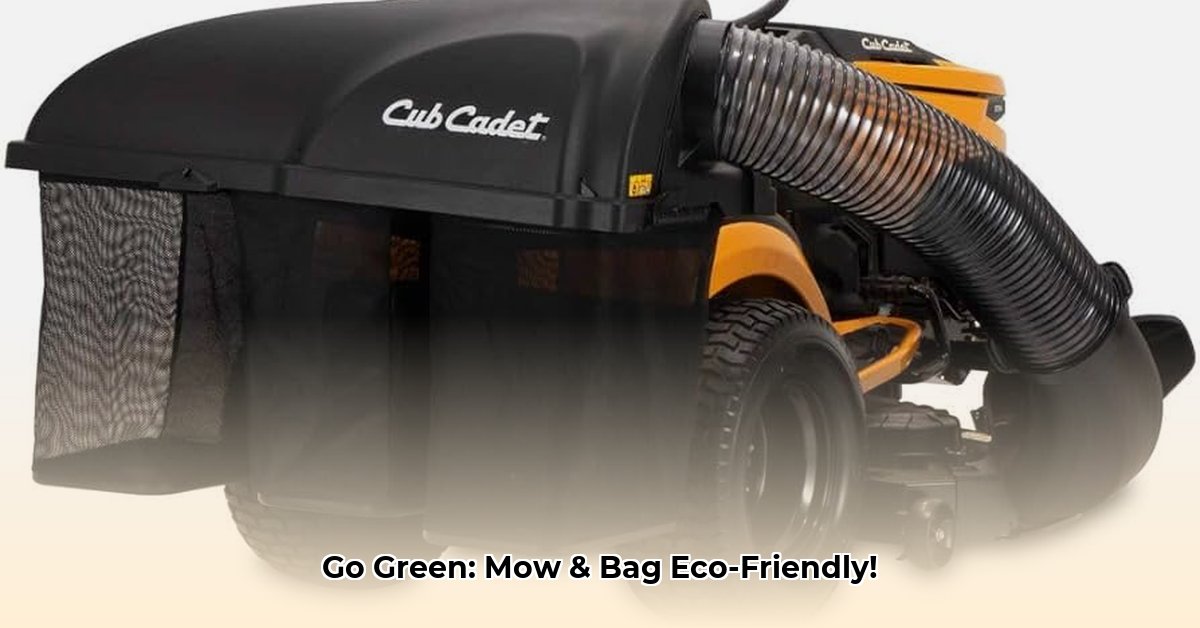
This guide provides a comprehensive review and instructional manual for using a Cub Cadet lawn tractor grass bagger, focusing on sustainable lawn management practices. We'll cover everything from choosing the right model to composting your grass clippings, ensuring a beautiful and environmentally conscious lawn. For more Cub Cadet resources, check out this helpful website.
Choosing Your Cub Cadet Grass Bagger: A Perfect Fit for Your Lawn
Selecting the right Cub Cadet grass bagger hinges on two key factors: your lawn's size and your Cub Cadet tractor's model. A small bagger on a large lawn means constant emptying, while an oversized bagger on a small lawn is inefficient. Always consult your tractor's manual to ensure compatibility. This crucial step prevents potential issues and saves you money in the long run.
Installing and Using Your Bagger: A Step-by-Step Process
Installing your Cub Cadet bagger is generally straightforward, but always refer to your owner's manual for precise instructions. Typically, you'll attach the bag to the mower's discharge chute, securing it with clips or straps. Ensure a tight fit to prevent any loose parts which could cause problems. Remember to regularly empty the bag; smaller, lighter loads are much easier to manage than a single, heavy one.
Optimizing Grass Collection: Techniques for Efficient Bagging
Efficient grass collection goes beyond simply mowing. Cutting height is paramount. Mowing too low stresses the grass, increasing vulnerability to pests and diseases. Mowing too high results in long clippings difficult to bag. Find the optimal height suited to your grass type. Regular mowing, ideally once a week, promotes even growth. Finally, avoid mowing wet grass; damp clippings clump, causing clogs.
Sustainable Disposal & Composting: Giving Grass a Second Life
Landfilling grass clippings is environmentally wasteful. Composting offers a superior alternative, transforming clippings into nutrient-rich fertilizer. Composting involves layering grass clippings with other organic materials like leaves and twigs, regularly turning the pile to facilitate decomposition. Many municipalities provide curbside composting programs—check your local options. "Home composting is a fantastic way to recycle yard waste and create nutrient-rich soil amendment," says Dr. Emily Carter, Horticultural Scientist at the University of California, Davis.
The Environmental Impact: A Holistic Perspective
While a Cub Cadet grass bagger enhances lawn aesthetics and reduces raking, consider its environmental footprint. The bagger's manufacturing uses resources; consider its materials (recyclable?) and lifespan. Responsible disposal is key. Investing in a durable, high-quality bagger extends its lifespan, reducing replacements and fostering long-term sustainability.
Alternatives to Bagging: Exploring Sustainable Options
Mulching provides a sustainable alternative to bagging. This method finely chops clippings, distributing them evenly across the lawn. They decompose rapidly, acting as natural fertilizer, reducing reliance on synthetic fertilizers. While offering improved soil health, mulching might not deliver the pristine lawn appearance of bagging.
Troubleshooting and Maintenance: Ensuring Long-Term Performance
Regular maintenance is vital for optimal bagger performance. Empty the bag frequently to prevent clogs. Clean the discharge chute to avoid blockages, and inspect for wear and tear. Addressing minor issues promptly prevents costly repairs. A well-maintained bagger provides years of reliable service.
Pros and Cons of Using a Cub Cadet Grass Bagger: A Balanced View
| Pros | Cons |
|---|---|
| Cleaner, neater lawn appearance | Requires regular emptying and maintenance |
| Reduced need for raking | Added cost compared to mulching |
| Efficient grass collection | Potential for clogs if not maintained properly |
| Easier handling of grass clippings | Can be bulky to store when not in use |
| Improved soil health (with proper disposal) | Adds to overall lawn care workload |
How to Compost Grass Clippings Effectively
"Efficient grass clipping management requires balancing decomposition methods (grasscycling, composting), herbicide considerations, and nutrient cycling," notes Dr. Robert Brown, Professor of Agronomy at Purdue University. Grasscycling (leaving clippings on the lawn) is simple and nutrient-rich for short grass. Composting offers control for larger volumes or herbicide-treated grass. Achieving the ideal carbon-to-nitrogen ratio is crucial for efficient composting, and hot composting significantly reduces weed seed propagation.
This guide empowers you to achieve a beautiful lawn while minimizing your environmental impact. Remember that sustainable lawn care is an ongoing process. By utilizing your Cub Cadet grass bagger wisely and embracing environmentally friendly practices, you can contribute to a healthier planet.